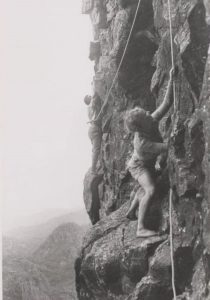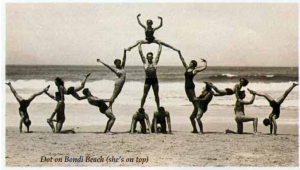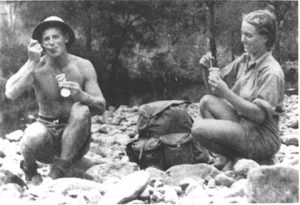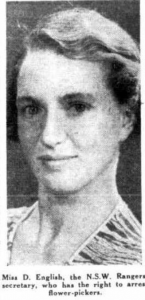The Barefoot Bushwalker: Dorothy Butler

Dorothy English and Dr Eric Dark climbing Crater Bluff in the Warrumbungles, 1936
Courtesy National Museum of Australia
‘I was born a climber.’
Dorothy Butler (née English), the intrepid ‘barefoot bushwalker’ was born in 1911. She was the fourth of five children born to Frank Alfred English and Isadora (née Goff) who were married in Summer Hill in December 1905. The family briefly moved to Brisbane after Dorothy’s birth and youngest child, Harold was born there in 1913. Frank English was a commercial traveller for a pharmaceutical company – and rarely home. He had left the family entirely by about 1920, and was later listed as a journalist living in Mount Kuring-gai. Isadora was a teacher and psychologist who encouraged self-expression in her children. Dorothy was always a tomboy.
Dorothy attended Homebush Public School from 1916 to 1921 but it is unclear exactly where the family was living at this time as neither Frank nor Isadora appear in Sands’ Directories. Dorothy was a good student and excelled at sport.
Of her childhood, Dot said:
‘We lived our young life in Sydney’s western suburbs. We had no money and took it for granted that we had to make our own fun. Wiry and barefoot (none of us owned shoes till we went to high school), we ranged over our local territory, racing like a pack of young baboons up and down and over everything, man-made and natural, that offered the slightest scope for getting off the horizontal.’
‘Sundays, our pockets full of loquats and green quinces, we would trail off through the sheep paddocks which in those days occupied a good part of the southern side of Homebush, through the marsh and ti-trees of Potts Bush, to the Chullora Railway yards. Just as the Sydney Rock Climbers haunt the Blue Mountains rock faces, so this place was our favourite testing ground. The prize was the great crane whose week-day job was to lift locomotives around. On Sundays it sat there, huge and unused. We would make a swift sortie from the railway cutting, up the arm, slide down the wire cable and away before the caretaker spotted us and grabbed up his saltpetre gun. You can see that the race was to the swift. The railway yards possessed a great clay embankment, now removed. The civic fathers who tidy up their suburbs so that there are no wild challenges for the young climber are doing the present generation a great disservice.’
‘In the railway yards I tried out my first experiment in artificial climbing. This revolved round a sawn-off screwdriver. It had a smooth, wooden handle, sympathetic to the grip. From the base of the clay cliff we would eye off a feasible route, then make a long run and get as high as we could with the impetus. The first pitch was invariably done in a state of swift excitement. The screwdriver would be plunged in with a mighty swing, the bare feet would rapidly excavate a toehold in the dry clay, and the climb was well started. So we ticked off all the mighty climbs close to home – sandstone quarries, clay pits, brick-kiln chimneys (up their dark inside, where the littlest brother had difficulty getting started as his legs would barely stretch across), the outside of buildings, down wells, up posts and poles and pipes, trees and wires and cables. It was a glorious childhood.’
Dot went on to attend Sydney Girls’ High School, becoming a stenographer but later studying physiotherapy at Sydney University and working with polio survivors at the Royal Alexandra Hospital for Children at Collaroy. She cycled 150 miles per week between home, work and the university. She was also active in the Bondi Beach Acrobatic Team during the late 1920s. That’s her at the very top of the pyramid.

Courtesy Dorothy Butler: The Barefoot Bushwalker (1911-2008)
http://www.bushwalkermagazine.org/dorothy%27s-tribute.pdf
Dorothy joined the Sydney Bush Walkers Club in about 1931. As she said herself: ‘bushwalking and I were made for each other. For twelve years I never missed a week-end in the bush.’
She was an influential member of the club until the 1990s and wrote many articles about her walks and climbs for its journal, the Sydney Bush Walkers Magazine. Dot was also an avid conservationist. She celebrated her 21st birthday by cycling to Mount Kosciuszko, camping along the way.
Having earned some money from her first job as a stenographer, Dot took herself off to Tasmania for a solo adventure on her bike. She spent several weeks cycling around the island – barefoot, wearing shorts, camping in cemeteries and foraging for food. An early vegetarian, she was content to eat fruit along the way. Her exploits were later published in the Daily Telegraph under the heading: How to Holiday with No Money.

Jack Debert & Dot Butler eating icecream on the Kowmung River. Courtesy Alex Colley and the Sydney Bush Walkers
By 1935 Dot was living in Lindfield with her mother and brother, Herbert. In 1936 Dot and Dr Eric Dark, the husband of author, Eleanor Dark, were the first to scale Crater Bluff in the Warrumbungles. This was Dorothy’s first introduction to ‘technical’ climbing – with a rope. After this she founded a rock-climbing section of the Sydney Bush Walkers, known as the ‘Tigers.’ Australia’s first female lawyer and mountaineer, Marie Byles donated a rope and became a lifelong friend.

Weekly Times (Melbourne) 4 January 1936 p.9
https://trove.nla.gov.au/newspaper/article/224861194
Dot also became an honorary ranger and was secretary of the NSW Rangers. She was scathing of ‘hikers’ who picked wildflowers and left behind rubbish, graffiti and signs. Bushwalkers were apparently a different breed.
In 1937 Dot first visited New Zealand to climb, beginning a long association with the country. She was accepted into the New Zealand Alpine Club and spent some time as a guide at Mount Cook.
She later recalled: ‘I remember a long, lanky young man who was learning the rudiments of climbing at that time … We used to laugh at him in his sandshoes and people would say “Fancy that young man thinking he can climb!”’
That young man was Edmund Hillary who, with Tenzing Norgay, became the first to climb Mount Everest in 1953.
Through the Sydney Bush Walkers Dot met economist, Ira Butler. When they decided to marry in 1943, Ira was working in Melbourne. Unable to get a seat on a wartime train from Sydney to Melbourne for her own wedding, Dorothy cycled the entire way. A few years later she again cycled from Melbourne to Albury while six months pregnant. One of her later, home-built bicycles is in the collection of the National Museum of Australia, donated by fellow walker, Alex Colley OAM. Dot was still riding it at the age of 80.
In 1956, concerned at the inexperience of some over-confident climbers, Dot established the Australian branch of the New Zealand Alpine Club so that Australian mountaineers could be well-trained at home before attempting the icy peaks of Mount Cook – among others.
In 1969 Dorothy found and acquired the 90-acre Coolana property at Kangaroo Valley on behalf of the Sydney Bush Walkers. The group retains this property today. It adjoins the Dot Butler Conservation Area, gazetted in 2012. Dots Creek is also nearby. Also in 1969 Dorothy organised the Australian Andean Expedition to Peru, and over the next two years she climbed and cycled in Peru, the United Kingdom, Germany, Russia, Spain, Nepal and Cambodia. In the wake of the devastating earthquake in Peru on 31 May 1970, in which 70,000 people died, Dot spent the next 20 years fundraising for victims of the tragedy. In 1972 she climbed in Switzerland and Norway.
Many of Dot’s exploits went unrecorded. Unbeknownst to authorities, she scaled the Sydney Harbour Bridge several times illegally over the years, including with a boyfriend on its opening day in 1932. On that occasion she watched as de Groot slashed the ribbon with his sword from her hiding place far above. In 1992 she climbed it again – and abseiled down, aged 80.
Ira and Dorothy Butler had four children – Rona, Wendy and twins, Norman and Wade. They grew up sharing their mother’s love of adventurous pursuits but sadly, only Rona outlived Dot. Wendy died in a drowning accident in the Kowmung River in the Blue Mountains in 1966, aged 20. Norman died of a taipan bite near Nimbin in 1974. Ira had died from a heart attack at home in Wahroonga in November 1972. In 1995 Wade disappeared on a solo six-day trek near Precipitous Bluff in Tasmania and was never found. Dick Smith funded the private search that followed the initial search and teams of rescuers flew to Tasmania to assist.
Dot was named Australian Geographic’s ‘Adventurer of the Year’ in 1988. She was still walking – barefoot of course – in her eighties. In her later years Dorothy moved to Tasmania to be close to her surviving daughter, Rona and her family. She died there in 2008, aged 96 and her ashes were scattered in the Warrumbungle National Park.
Mount Dot in the Southland region of New Zealand was named in honour of the indomitable Dorothy Butler, as was Dot Butler Street, Wright in Canberra.
A life well lived, indeed.
by J.J. MacRitchie
Local Studies Advisor
References
The Australian Women’s Weekly 23 March 1966 p.7 https://trove.nla.gov.au/newspaper/article/47251012
NSW electoral rolls
Butler, Dot ‘Reflections of a Climber’ reprinted from the Sydney Rock Climbers magazine ‘Thrutch’ 1967. https://sbw.ozultimate.com/wiki/197803
SBW Magazine & History project https://sbw.ozultimate.com/wiki/197803
Daily Telegraph 4 December 1937 p.4 https://trove.nla.gov.au/newspaper/article/247331331
Geographical Sites of NSW. Warrumbungle National Park https://www.geomaps.com.au/scripts/warrumbungle.php
Weekly Times (Melbourne) 4 January 1936 p.9 https://trove.nla.gov.au/newspaper/article/224861194
State Library of NSW http://archival.nsw.gov.au/Details/archive/110317088
National Museum of Australia http://collectionsearch.nma.gov.au/object/77182
The Sydney Bushwalker No.773 April 1999 https://sbw.ozultimate.com/wiki/199904199904
NSW Place and Road Naming Proposals System. Dot Butler Conservation Reserve. https://proposals.gnb.nsw.gov.au/public/geonames/7f210355-96eb-4e53-a0ee-8e8d41036956
Canberra Times 16 Mar 1992 p.1 https://trove.nla.gov.au/newspaper/article/122404029
Dot Butler – Wikipedia https://en.wikipedia.org/wiki/Dot_Butler
The Bushwalker February 1996 Vol.21 No.3 1996 http://www.bushwalkingnsw.org.au/bushwalking/wp-content/uploads/2014/07/1996-Feb.pdf
Dorothy Butler – the Barefoot Bushwalker | Jane Elix’s blog https://janeelix.wordpress.com/2011/07/27/dorothy-butler-the-barefoot-bushwalker/
Mount Dot, Southland – NZ Topo Map https://www.topomap.co.nz/NZTopoMap?v=2&ll=-44.569343,168.044243&z=14

2 Comments. Leave new
What an amazing, intrepid woman! She deserves to be better known.
What a legend Dot was, I got excited reading about her. Thank you